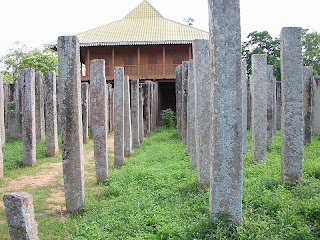The
city of Anuradhapura is a UNESCO World Heritage Site. City Locate in Sri Lanka's North Central Province, 205 km north of the
Colombo capital city, Anuradhapura city on the
banks of the historic Malvathu Oya.
Anuradhapura was the capital of Sri Lanka from the 4th century BC to the beginning of the 11th century AD. During this period city was remained one of the most stable and durable spring-head of political power and civilized life in South Asia. The ancient city, considered sacred in the Buddhist world. Over forty square kilometer (40km²) or sixteen square miles covering an area by monasteries.
History
Prince Vijaya (543 to 505 BC) after having been banished from his homeland in India. He Arrived in 543 BC to Dhabacolapatuna in Sri Lanka. Finally brought the island under his rule himself as a King, his retinue established villages and colonies all over the country. One of these was established by Anuradha, a one of the minister in King Vijaya's rajasabaha (cabinet), on the banks of a stream called Kolon and he was named it Anuradhagama.
King Pandukabhaya (437 BC to 367 BC) era, created it his capital and well developed it into a prosperous city in 377 BC. Anuradhapura (Anurapura) was renamed after the minister who first established the city and also after a grandfather of Pandukabhaya.
The name was also derived from the city's establishment on the auspicious asterism called Anura. Anuradhapura was the capital of all the monarchs who ruled the country during in the Anuradhapura Kingdom, with the exception of king Kashyapa (473–491), who chose Sigiriya to be his capital. The city is also marked on Sri Lanka's first map of Ptolemy's world map
Anuradhapura was the capital of Sri Lanka from the 4th century BC to the beginning of the 11th century AD. During this period city was remained one of the most stable and durable spring-head of political power and civilized life in South Asia. The ancient city, considered sacred in the Buddhist world. Over forty square kilometer (40km²) or sixteen square miles covering an area by monasteries.
History
Prince Vijaya (543 to 505 BC) after having been banished from his homeland in India. He Arrived in 543 BC to Dhabacolapatuna in Sri Lanka. Finally brought the island under his rule himself as a King, his retinue established villages and colonies all over the country. One of these was established by Anuradha, a one of the minister in King Vijaya's rajasabaha (cabinet), on the banks of a stream called Kolon and he was named it Anuradhagama.
King Pandukabhaya (437 BC to 367 BC) era, created it his capital and well developed it into a prosperous city in 377 BC. Anuradhapura (Anurapura) was renamed after the minister who first established the city and also after a grandfather of Pandukabhaya.
The name was also derived from the city's establishment on the auspicious asterism called Anura. Anuradhapura was the capital of all the monarchs who ruled the country during in the Anuradhapura Kingdom, with the exception of king Kashyapa (473–491), who chose Sigiriya to be his capital. The city is also marked on Sri Lanka's first map of Ptolemy's world map
Eight Great Places of Veneration in Anuradhapura - Also called Atamasthana
- Sri Maha Bodiya
- Ruwanwelisaya
- Thuparamaya
- Lovamahapaya
- Abayagiriya
- Jethavanaramaya
- Mirisavetiya
- Lankaramaya














